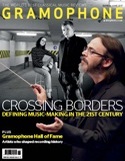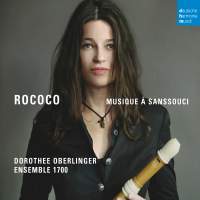Texte paru dans: / Appeared in: |
|
|
Outil de traduction (Très approximatif) |
|
|
Reviewer: Charlotte Gardner ‘Rococo’, for which Dorothee Oberlinger directs the brilliant Ensemble 1700, may be themed around Sanssouci but this is no narrow Frederick-the-Great-themed selection of works. Instead it begins in the musical world of his grandparents, the programme seductively flowering into being with a 1704 lute-accompanied ground by the Moravian violist Gottfried Finger, Oberlinger eliciting a softly airy, open sound from her alto recorder in E flat by Meyer (a special size between alto and voiceflute, voiceflute sitting between alto and tenor), with subtle vibrato and ornamentations, lines spun long and wide even as the variations increase in floridity, and the overall legato coloured every so often by rapid individually articulated notes punched out with energetic precision. Another pre-Frederick pleasure is the 17‑year-old Handel’s Double Concerto for recorder and bassoon, for which Oberlinger is joined by bassoonist Makiko Kurabayashi. Here, as with the Finger, Oberlinger has chosen her instruments to great affect; a tenor by Francesco Livirghi for the slow movements, whose mellowness she then complements in the fast movements with a forthflute in B flat by Tim Cranmore – forthflutes being a sort of soprano recorder d’amore – from which she draws a gloriously clean, clear and wide tone throughout the high-register writing. Among the Frederick the Greatshaped pleasures is a courtly Sarabande by Quantz on a Meyer voiceflute, plus a jaunty Alla francese whose bundles of dizzying semiquavers Oberlinger renders into birdsong, perky bounce juxtaposed with liquid flow, her tone constantly varying. Her instrument here is another forthflute, this one by di Paolis, but vexingly you won’t read this in the bookletnotes because although her array of models are listed they haven’t been matched to tracks. So, for your information, in the CPE Bach Sonata you’re hearing a bass recorder by Luca di Paolis, and for his solo sonata an Ernst Meyer voiceflute. Baron’s D minor Concerto for recorder and lute is on a Ehlert alto. The Graun and Schultze concertos feature two of Meyer’s Denner altos, and for the Janitsch quartet a Bressan of his. The omission of this information is a minor point, though. Ultimately, what matters is that by the time ‘Rococo’ ends, Schultze’s sparky concerto taking us as close to the Classical era as the recorder can, you truly feel as though you’ve been taken on a beautiful musical journey. |
|




